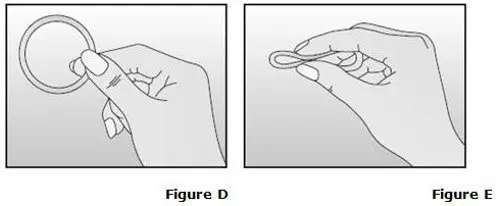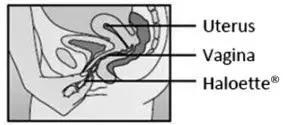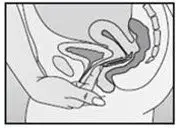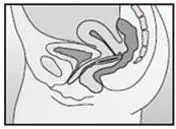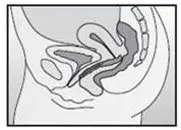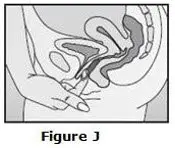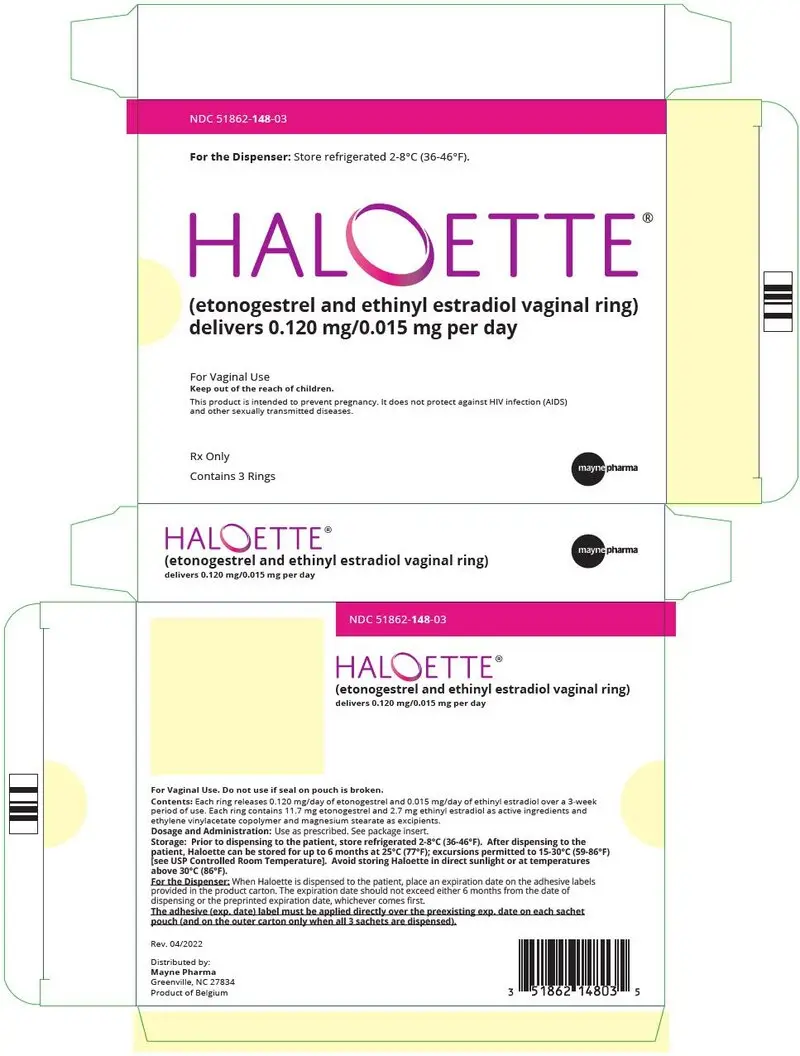Drug Class: Contraceptives
Highlights of Prescribing Information
HALOETTE® (etonogestrel and ethinyl estradiol vaginal ring)
Initial U.S. Approval: 2001
WARNING: CIGARETTE SMOKING AND SERIOUS CARDIOVASCULAR EVENTS
See full prescribing information for complete boxed warning.
- Women over 35 years old who smoke should not use Haloette. (4)
- Cigarette smoking increases the risk of serious cardiovascular events from combination hormonal contraceptive (CHC) use. (4)
Recent Major Changes
| Warnings and Precautions (5.14) | 04/2022 |
Indications and Usage for Haloette
Haloette is an estrogen/progestin combination hormonal contraceptive (CHC) indicated for use by women to prevent pregnancy. (1)
Haloette Dosage and Administration
One Haloette is inserted in the vagina. The ring must remain in place continuously for three weeks, followed by a one-week ring-free interval. (2)
Dosage Forms and Strengths
Haloette is a polymeric vaginal ring containing 11.7 mg etonogestrel and 2.7 mg ethinyl estradiol, which releases on average 0.12mg/day of etonogestrel and 0.015mg/day of ethinyl estradiol. (3)
Contraindications
- A high risk of arterial or venous thrombotic diseases (4)
- Breast cancer (4)
- Liver tumors or liver disease (4)
- Undiagnosed abnormal uterine bleeding (4)
- Pregnancy (4)
- Hypersensitivity, including anaphylaxis and angioedema, to any of the components of Haloette (4)
- Co-administration with Hepatitis C drug combinations containing ombitasvir/paritaprevir/ritonavir, with or without dasabuvir (4)
Warnings and Precautions
- Vascular risks: Stop Haloette use if a thrombotic event occurs. Stop Haloette use at least 4 weeks before and through 2 weeks after major surgery. Start no earlier than 4 weeks after delivery, in women who are not breastfeeding. (5.1)
- Toxic Shock Syndrome (TSS): If patient exhibits signs or symptoms of TSS, consider the possibility of this diagnosis and initiate appropriate medical evaluation and treatment. (5.2)
- Liver disease: Discontinue Haloette use if jaundice develops. (5.3)
- High blood pressure: If used in women with well-controlled hypertension, monitor blood pressure and stop Haloette use if blood pressure rises significantly. (5.5)
- Carbohydrate and lipid metabolic effects: Monitor prediabetic and diabetic women. Consider an alternate contraceptive method for women with uncontrolled dyslipidemia. (5.9)
- Headache: Evaluate significant change in headaches and discontinue Haloette use if indicated. (5.10)
- Uterine bleeding: Evaluate irregular bleeding or amenorrhea. (5.11)
Adverse Reactions/Side Effects
The most common adverse reactions (≥2%) in clinical trials were: vaginitis, headache (including migraine), mood changes (e.g., depression, mood swings, mood altered, depressed mood, affect lability), device-related events (e.g., expulsion/discomfort/foreign body sensation), nausea/vomiting, vaginal discharge, increased weight, vaginal discomfort, breast pain/discomfort/tenderness, dysmenorrhea, abdominal pain, acne, and decreased libido. (6)
To report SUSPECTED ADVERSE REACTIONS, contact Mayne Pharma, at 1-844-825-8500 or FDA at 1-800-FDA-1088 or www.fda.gov/medwatch.
Drug Interactions
Drugs or herbal products that induce certain enzymes, such as CYP3A4, may decrease the effectiveness of CHCs or increase breakthrough bleeding. Counsel patients to use a back-up or alternative method of contraception when enzyme inducers are used with CHCs. (7)
Use In Specific Populations
- Nursing mothers: Not recommended; can decrease milk production. (8.2)
See 17 for PATIENT COUNSELING INFORMATION and FDA-approved patient labeling.
Revised: 5/2022
Full Prescribing Information
WARNING: CIGARETTE SMOKING AND SERIOUS CARDIOVASCULAR EVENTS
Cigarette smoking increases the risk of serious cardiovascular events from combination hormonal contraceptive (CHC) use. This risk increases with age, particularly in women over 35 years of age, and with the number of cigarettes smoked. For this reason, CHCs, including Haloette, should not be used by women who are over 35 years of age and smoke. [See Contraindications (4).]
1. Indications and Usage for Haloette
FOR VAGINAL USE ONLY
Haloette® is indicated for use by females of reproductive age to prevent pregnancy.
2. Haloette Dosage and Administration
2.1 How to Use Haloette
To achieve maximum contraceptive effectiveness, Haloette must be used as directed [see Dosage and Administration (2.2)]. One Haloette is inserted in the vagina. The ring is to remain in place continuously for three weeks. It is removed for a one-week break, during which a withdrawal bleed usually occurs. A new ring is inserted one week after the last ring was removed.
The user can choose the insertion position that is most comfortable to her, for example, standing with one leg up, squatting, or lying down. The ring is to be compressed and inserted into the vagina. The exact position of Haloette inside the vagina is not critical for its function. The vaginal ring must be inserted on the appropriate day and left in place for three consecutive weeks. This means that the ring should be removed three weeks later on the same day of the week as it was inserted and at about the same time.
Haloette can be removed by hooking the index finger under the forward rim or by grasping the rim between the index and middle finger and pulling it out. The used ring should be placed in the sachet (foil pouch) and discarded in a waste receptacle out of the reach of children and pets (do not flush in toilet).
After a one-week break, during which a withdrawal bleed usually occurs, a new ring is inserted on the same day of the week as it was inserted in the previous cycle. The withdrawal bleed usually starts on Day 2-3 after removal of the ring and may not have finished before the next ring is inserted. In order to maintain contraceptive effectiveness, the new ring must be inserted exactly one week after the previous one was removed even if menstrual bleeding has not finished.
2.3 Deviations from the Recommended Regimen
To prevent loss of contraceptive efficacy, advise women not to deviate from the recommended regimen. Haloette should be left in the vagina for a continuous period of three weeks. Advise women to regularly check for the presence of Haloette in the vagina (for example, before and after intercourse).
2.4 In the Event of a Missed Menstrual Period
- If the woman has not adhered to the prescribed regimen (Haloette has been out of the vagina for more than three hours or the preceding ring-free interval was extended beyond one week), consider the possibility of pregnancy at the time of the first missed period and discontinue Haloette use if pregnancy is confirmed.
- If the woman has adhered to the prescribed regimen and misses two consecutive periods, rule out pregnancy.
- If the woman has retained one Haloette for longer than four weeks, rule out pregnancy.
2.5 Use with Other Vaginal Products
Haloette may interfere with the correct placement and position of certain female barrier methods such as a diaphragm, cervical cap or female condom. These methods are not recommended as back-up methods with Haloette use.
Pharmacokinetic data show that the use of tampons has no effect on the systemic absorption of the hormones released by Haloette.
3. Dosage Forms and Strengths
Haloette (etonogestrel and ethinyl estradiol vaginal ring) is a non-biodegradable, flexible, transparent, colorless to almost colorless, combination contraceptive vaginal ring, with an outer diameter of 54 mm and a cross-sectional diameter of 4 mm. It is made of ethylene vinylacetate copolymers and magnesium stearate, and contains 11.7 mg etonogestrel and 2.7 mg ethinyl estradiol. When placed in the vagina, each ring releases on average 0.120 mg/day of etonogestrel and 0.015 mg/day of ethinyl estradiol over a three-week period of use. Haloette is not made with natural rubber latex.
4. Contraindications
Do not prescribe Haloette to women who are known to have or use the following:
- A high risk of arterial or venous thrombotic diseases. Examples include women who are known to:
- Smoke, if over age 35 [see Boxed Warning and Warnings and Precautions (5.1)]
- Have deep vein thrombosis or pulmonary embolism, now or in the past [see Warnings and Precautions (5.1)]
- Have cerebrovascular disease [see Warnings and Precautions (5.1)]
- Have coronary artery disease [see Warnings and Precautions (5.1)]
- Have thrombogenic valvular or thrombogenic rhythm diseases of the heart (for example, subacute bacterial endocarditis with valvular disease, or atrial fibrillation) [see Warnings and Precautions (5.1)]
- Have inherited or acquired hypercoagulopathies [see Warnings and Precautions (5.1)]
- Have uncontrolled hypertension [see Warnings and Precautions (5.5)]
- Have diabetes mellitus with vascular disease [see Warnings and Precautions (5.9)]
- Have headaches with focal neurological symptoms or migraine headaches with aura [see Warnings and Precautions (5.10)]
- Women over age 35 with any migraine headaches [see Warnings and Precautions (5.10)]
- Liver tumors, benign or malignant or liver disease [see Warnings and Precautions (5.3) and Use in Specific Populations (8.6)]
- Undiagnosed abnormal uterine bleeding [see Warnings and Precautions (5.11)]
- Pregnancy, because there is no reason to use CHCs during pregnancy [see Use in Specific Populations (8.1)]
- Current diagnosis of, or history of, breast cancer, which may be hormone-sensitive [see Warnings and Precautions (5.14)]
- Hypersensitivity reactions, including anaphylaxis and angioedema, to any of the components of Haloette [see Warnings and Precautions (5.6) and Adverse Reactions (6)]
- Use of Hepatitis C drug combinations containing ombitasvir/paritaprevir/ritonavir, with or without dasabuvir, due to potential for ALT elevations [see Warnings and Precautions (5.4)]
5. Warnings and Precautions
5.1 Thromboembolic Disorders and Other Vascular Problems
Stop Haloette use if an arterial thrombotic or venous thromboembolic event (VTE) occurs. Stop Haloette use if there is unexplained loss of vision, proptosis, diplopia, papilledema, or retinal vascular lesions. Evaluate for retinal vein thrombosis immediately. [See Adverse Reactions (6).]
If feasible, stop Haloette at least four weeks before and through two weeks after major surgery or other surgeries known to have an elevated risk of thromboembolism, and during and following prolonged immobilization.
Start Haloette no earlier than 4 weeks after delivery, in women who are not breastfeeding. The risk of postpartum thromboembolism decreases after the third postpartum week, whereas the risk of ovulation increases after the third postpartum week.
The use of CHCs increases the risk of VTE. Known risk factors for VTE include smoking, obesity, and family history of VTE, in addition to other factors that contraindicate use of CHCs [see Contraindications (4)].
Two epidemiologic studies1, 2, 3 that assessed the risk of VTE associated with the use of etonogestrel and ethinyl estradiol vaginal ring are described below.
In these studies, which were required or sponsored by regulatory agencies, etonogestrel and ethinyl estradiol vaginal ring users had a risk of VTE similar to Combined Oral Contraceptives (COCs) users (see Table 1 for adjusted hazard ratios). A large prospective, observational study, the Transatlantic Active Surveillance on Cardiovascular Safety of etonogestrel and ethinyl estradiol vaginal ring (TASC), investigated the risk of VTE for new users, and women who were switching to or restarting etonogestrel and ethinyl estradiol vaginal ring or COCs in a population that is representative of routine clinical users. The women were followed for 24 to 48 months. The results showed a similar risk of VTE among etonogestrel and ethinyl estradiol vaginal ring users (VTE incidence 8.3 per 10,000 WY) and women using COCs (VTE incidence 9.2 per 10,000 WY). For women using COCs that did not contain the progestins desogestrel (DSG) or gestodene (GSD), VTE incidence was 8.9 per 10,000 WY.
A retrospective cohort study using data from 4 health plans in the US (FDA-funded Study in Kaiser Permanente and Medicaid databases) showed the VTE incidence for new users of etonogestrel and ethinyl estradiol vaginal ring to be 11.4 events per 10,000 WY, for new users of a levonorgestrel(LNG)-containing COC 9.2 events per 10,000 WY, and for users of other COCs available during the course of the study18.2eventsper10,000 WY.
| Epidemiologic Study (Author, Year of Publication) Population Studied | Comparator Product(s) | Hazard Ratios (HR) (95% CI) |
|---|---|---|
|
||
| TASC (Dinger, 2012) | ||
| Initiators, including new users, switchers and restarters | All COCs available during the course of the study * | HR†: 0.8 (0.5-1.5) |
| COCs available excluding DSG- or GSD -containing OCs | HR†: 0.8 (0.4-1.7) |
|
| FDA-funded Study in Kaiser Permanente and Medicaid databases (Sidney, 2011) | ||
| First use of a combined hormonal contraceptive (CHC) during the study period | COCs available during the course of the study‡ | HR§: 1.1 (0.6-2.2) |
| LNG/0.03 mg ethinyl estradiol | HR§: 1.0 (0.5-2.0) |
|
An increased risk of thromboembolic and thrombotic disease associated with the use of CHCs is well- established. Although the absolute VTE rates are increased for users of CHCs compared to non-users, the rates associated with pregnancy are even greater, especially during the post-partum period (see Figure 1).
The frequency of VTE in women using CHCs has been estimated to be 3 to 12 cases per 10,000 women-years.
The risk of VTE is highest during the first year of CHC use and after restarting a CHC following a break of at least four weeks. The risk of VTE due to CHCs gradually disappears after use is discontinued.
Figure 1 shows the risk of developing a VTE for women who are not pregnant and do not use CHCs, for women who use CHCs, for pregnant women, and for women in the postpartum period. To put the risk of developing a VTE into perspective: If 10,000 women who are not pregnant and do not use CHCs are followed for one year, between 1 and 5 of these women will develop a VTE.
Figure 1: Likelihood of Developing a VTE
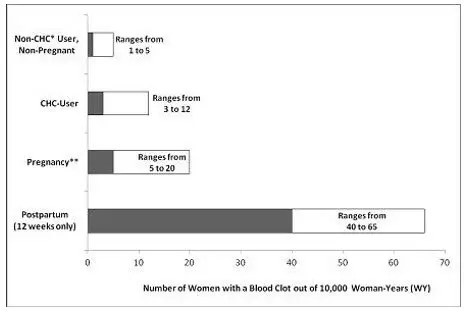
*CHC=combination hormonal contraception
**Pregnancy data based on actual duration of pregnancy in the reference studies. Based on a model assumption that pregnancy duration is nine months, the rate is 7 to 27 per 10,000 WY.
Several epidemiology studies indicate that third generation oral contraceptives, including those containing desogestrel (etonogestrel, the progestin in Haloette, is the biologically active metabolite of desogestrel), may be associated with a higher risk of VTE than oral contraceptives containing other progestins. Some of these studies indicate an approximate two-fold increased risk. However, data from other studies have not shown this two-fold increase in risk.
Use of CHCs also increases the risk of arterial thromboses such as strokes and myocardial infarctions, especially in women with other risk factors for these events. CHCs have been shown to increase both the relative and attributable risks of cerebrovascular events (thrombotic and hemorrhagic strokes). In general, the risk is greatest among older (>35 years of age), hypertensive women who also smoke.
Use Haloette with caution in women with cardiovascular disease risk factors.
- 1
- Includes low-dose COCs containing the following progestins: norgestimate, norethindrone, or levonorgestrel.
5.2 Toxic Shock Syndrome (TSS)
Cases of TSS have been reported by etonogestrel and ethinyl estradiol vaginal ring users. TSS has been associated with tampons and certain barrier contraceptives, and, in some cases the etonogestrel and ethinyl estradiol vaginal ring users were also using tampons. A causal relationship between the use of Haloette and TSS has not been established. If a patient exhibits signs or symptoms of TSS, consider the possibility of this diagnosis and initiate appropriate medical evaluation and treatment.
5.4 Risk of Liver Enzyme Elevations with Concomitant Hepatitis C Treatment
During clinical trials with the Hepatitis C combination drug regimen that contains ombitasvir/paritaprevir/ritonavir, with and without dasabuvir, ALT elevations greater than 5 times the upper limit of normal (ULN), including some cases greater than 20 times the ULN, were significantly more frequent in women using ethinyl estradiol-containing medications, such as CHCs. Discontinue Haloette prior to starting therapy with the combination drug regimen ombitasvir/paritaprevir/ritonavir, with or without dasabuvir [see Contraindications (4)]. Haloette can be restarted approximately 2 weeks following completion of treatment with the Hepatitis C combination drug regimen.
5.5 High Blood Pressure
Haloette is contraindicated in women with uncontrolled hypertension or hypertension with vascular disease [see Contraindications (4)]. For women with well-controlled hypertension, monitor blood pressure and stop Haloette use if blood pressure rises significantly.
An increase in blood pressure has been reported in women using CHCs and this increase is more likely in older women and with extended duration of use. The incidence of hypertension increases with increasing concentrations of progestin.
5.6 Hypersensitivity Reactions
Hypersensitivity reactions of anaphylaxis and angioedema have been reported during use of etonogestrel and ethinyl estradiol vaginal ring. If anaphylaxis and/or angioedema is suspected, Haloette should be discontinued and appropriate treatment administered. [See Contraindications (4).]
5.7 Vaginal Use
Haloette may not be suitable for women with conditions that make the vagina more susceptible to vaginal irritation or ulceration. Vaginal/cervical erosion or ulceration in women using etonogestrel and ethinyl estradiol vaginal ring has been reported. In some cases, the ring adhered to vaginal tissue, necessitating removal by a healthcare provider and in some instances (i.e., when the tissue had grown over the ring), removal was achieved by cutting the ring without incising the overlying vaginal tissue.
Some women are aware of the ring on occasion during the 21 days of use or during intercourse, and sexual partners may feel Haloette in the vagina.
5.8 Gallbladder Disease
Studies suggest a small increased relative risk of developing gallbladder disease among CHC users. Use of CHCs may also worsen existing gallbladder disease.
A past history of CHC-related cholestasis predicts an increased risk with subsequent CHC use. Women with a history of pregnancy-related cholestasis may be at an increased risk for CHC-related cholestasis.
5.9 Carbohydrate and Lipid Metabolic Effects
Carefully monitor prediabetic and diabetic women who are using Haloette. CHCs may decrease glucose tolerance.
Consider alternative contraception for women with uncontrolled dyslipidemia. Some women will have adverse lipid changes while on CHCs.
Women with hypertriglyceridemia, or a family history thereof, may be at an increased risk of pancreatitis when using CHCs.
5.10 Headache
If a woman using Haloette develops new headaches that are recurrent, persistent, or severe, evaluate the cause and discontinue Haloette if indicated.
Consider discontinuation of Haloette in the case of an increased frequency or severity of migraine during CHC use (which may be prodromal of a cerebrovascular event) [see Contraindications (4)].
5.12 Inadvertent Urinary Bladder Insertion
There have been reports of inadvertent insertions of etonogestrel and ethinyl estradiol vaginal ring into the urinary bladder, which required cystoscopic removal. Assess for ring insertion into the urinary bladder in Haloette users who present with persistent urinary symptoms and are unable to locate the ring.
5.13 Depression
Carefully observe women with a history of depression and discontinue Haloette use if depression recurs to a serious degree.
5.15 Effect on Binding Globulins
The estrogen component of CHCs may raise the serum concentrations of thyroxine-binding globulin, sex hormone-binding globulin, and cortisol-binding globulin. The dose of replacement thyroid hormones or cortisol therapy may need to be increased.
5.16 Monitoring
A woman who is using Haloette should have a yearly visit with her healthcare provider for a blood pressure check and for other indicated healthcare.
6. Adverse Reactions/Side Effects
The following serious adverse reactions with the use of CHCs are discussed elsewhere in the labeling.
- Serious cardiovascular events and stroke [see Boxed Warning and Warnings and Precautions (5.1)]
- Vascular events [see Warnings and Precautions (5.1)]
- Liver disease [see Warnings and Precautions (5.3)]
Adverse reactions commonly reported by CHC users are:
- Irregular uterine bleeding
- Nausea
- Breast tenderness
- Headache
6.2 Postmarketing Experience
Five studies that compared breast cancer risk between ever-users (current or past use) of COCs and never-users of COCs reported no association between ever use of COCs and breast cancer risk, with effect estimates ranging from 0.90 - 1.12 (Figure 2).Three studies compared breast cancer risk between current or recent COC users (<6 months since last use) and never users of COCs (Figure 2). One of these studies reported no association between breast cancer risk and COC use. The other two studies found an increased relative risk of 1.19 - 1.33 with current or recent use. Both of these studies found an increased risk of breast cancer with current use of longer duration, with relative risks ranging from 1.03 with less than one year of COC use to approximately 1.4 with more than 8-10 years of COC use.
Figure 2: Relevant Studies of Risk of Breast Cancer with Combined Oral Contraceptives

The following adverse reactions have been identified during post-approval use of etonogestrel and ethinyl estradiol vaginal ring. Because these reactions are reported voluntarily from a population of uncertain size, it is not always possible to reliably estimate their frequency or establish a causal relationship to drug exposure.
Immune system disorders: hypersensitivity reactions, including anaphylaxis and angioedema
Nervous system disorders: stroke/cerebrovascular accident
Vascular disorders: arterial events (including arterial thromboembolism and myocardial infarction), aggravation of varicose veins
Skin and subcutaneous tissue disorders: urticaria, chloasma
Reproductive system and breast disorders: penile disorders, including local reactions on penis (in male partners of women using etonogestrel and ethinyl estradiol vaginal ring), galactorrhea
General Disorders and Administration Site Conditions: device breakage (including with concomitant use of intravaginal antimycotic, antibiotic, and lubricant products)
Injury, poisoning and procedural complications: vaginal injury (including associated pain, discomfort, and bleeding) associated with ring breakage
7. Drug Interactions
Consult the labeling of all concurrently-used drugs to obtain further information about interactions with hormonal contraceptives or the potential for enzyme alterations.
7.2 Effects of CHCs on Other Drugs
CHCs containing ethinyl estradiol may inhibit the metabolism of other compounds (e.g., cyclosporine, prednisolone, theophylline, tizanidine, and voriconazole) and increase their plasma concentrations. CHCs have been shown to decrease plasma concentrations of acetaminophen, clofibric acid, morphine, salicylic acid and temazepam. A significant decrease in the plasma concentrations of lamotrigine has been shown, likely due to induction of lamotrigine glucuronidation. This may reduce seizure control; therefore, dosage adjustments of lamotrigine may be necessary.
Women on thyroid hormone replacement therapy may need increased doses of thyroid hormone because serum concentrations of thyroid-binding globulin increase with use of CHCs.
8. Use In Specific Populations
8.4 Pediatric Use
Safety and efficacy of Haloette have been established in women of reproductive age. Efficacy is expected to be the same for postpubertal adolescents under the age of 18 and for users 18 years and older. Use of this product before menarche is not indicated.
8.5 Geriatric Use
Haloette has not been studied in postmenopausal women and is not indicated in this population.
8.6 Hepatic Impairment
The effect of hepatic impairment on the pharmacokinetics of Haloette has not been studied. Steroid hormones may be poorly metabolized in patients with impaired liver function. Acute or chronic disturbances of liver function may necessitate the discontinuation of CHC use until markers of liver function return to normal. [See Contraindications (4) and Warnings and Precautions (5.3).]
10. Overdosage
There have been no reports of serious ill effects from overdose of CHCs. Overdosage may cause withdrawal bleeding in females and nausea. If the ring breaks, it does not release a higher dose of hormones. In case of suspected overdose, all Haloette rings should be removed and symptomatic treatment given.
11. Haloette Description
Haloette (etonogestrel and ethinyl estradiol vaginal ring) is a non-biodegradable, flexible, transparent, colorless to almost colorless, combination contraceptive vaginal ring containing two active components, a progestin, etonogestrel (13-ethyl-17-hydroxy-11-methylene-18,19-dinor-17α-pregn-4-en-20-yn-3-one) and an estrogen, ethinyl estradiol (19-nor-17α-pregna-1,3,5(10)-trien-20-yne-3,17-diol). When placed in the vagina, each ring releases on average 0.120 mg/day of etonogestrel and 0.015 mg/day of ethinyl estradiol over a three-week period of use. Haloette is made of ethylene vinylacetate copolymers (28% and 9% vinylacetate) and magnesium stearate and contains 11.7 mg etonogestrel and 2.7 mg ethinyl estradiol. Haloette is not made with natural rubber latex. Haloette has an outer diameter of 54 mm and a cross-sectional diameter of 4 mm. The molecular weights for etonogestrel and ethinyl estradiol are 324.46 and 296.40, respectively.
The structural formulas are as follows:
 |  |
| C22H28O2 | C20H24O2 |
12. Haloette - Clinical Pharmacology
12.1 Mechanism of Action
Combination hormonal contraceptives act by suppression of gonadotropins. Although the primary effect of this action is inhibition of ovulation, other alterations include changes in the cervical mucus (which increase the difficulty of sperm entry into the uterus) and the endometrium (which reduce the likelihood of implantation).
12.3 Pharmacokinetics
Absorption
Ethinyl estradiol: Ethinyl estradiol released by Haloette is rapidly absorbed. The bioavailability of ethinyl estradiol after vaginal administration is approximately 56%, which is comparable to that with oral administration of ethinyl estradiol. The serum ethinyl estradiol concentrations observed during three weeks of etonogestrel and ethinyl estradiol vaginal ring use are summarized in Table 2.
| 1 week | 2 weeks | 3 weeks | |
|---|---|---|---|
| etonogestrel (pg/mL) | 1578 (408) | 1476 (362) | 1374 (328) |
| ethinyl estradiol (pg/mL) | 19.1 (4.5) | 18.3 (4.3) | 17.6 (4.3) |
The pharmacokinetic profile of etonogestrel and ethinyl estradiol during use of etonogestrel and ethinyl estradiol vaginal ring is shown in Figure 2.
Figure 3: Mean Serum Concentration-Time Profile of Etonogestrel and Ethinyl Estradiol during Three Weeks of Etonogestrel and Ethinyl Estradiol Vaginal Ring Use
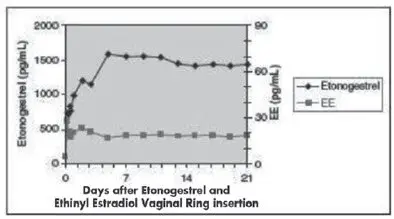
The pharmacokinetic parameters of etonogestrel and ethinyl estradiol were determined during one cycle of etonogestrel and ethinyl estradiol vaginal ring use in 16 healthy female subjects and are summarized in Table 3.
| Hormone | Cmax
pg/mL | Tmax
hr | t½
hr | CL L/hr |
|---|---|---|---|---|
| Cmax -maximum serum drug concentration Tmax -time at which maximum serum drug concentration occurs t1/2 -elimination half-life, calculated by 0.693/Kelim CL -apparent clearance |
||||
| etonogestrel | 1716 (445) | 200.3 (69.6) | 29.3 (6.1) | 3.4 (0.8) |
| ethinyl estradiol | 34.7 (17.5) | 59.3 (67.5) | 44.7 (28.8) | 34.8 (11.6) |
14. Clinical Studies
In three large one-year clinical trials enrolling 2,834 women aged 18-40 years, in North America, Europe, Brazil, and Chile, the racial distribution was 93% Caucasian, 5.0% Black, 0.8% Asian, and 1.2% Other. Women with BMI ≥ 30 kg/m2 were excluded from these studies.
Based on pooled data from the three trials, 2,356 women aged < 35 years completed 23,515 evaluable cycles of etonogestrel and ethinyl estradiol vaginal ring use (cycles in which no back-up contraception was used). The pooled pregnancy rate (Pearl Index) was 1.28 (95% CI [0.8, 1.9]) per 100 women-years of etonogestrel and ethinyl estradiol vaginal ring use. In the US study, the Pearl Index was 2.02 (95% CI [1.1, 3.4]) per 100 women-years of etonogestrel and ethinyl estradiol vaginal ring use.
Study data indicate the return of ovulation and spontaneous menstrual cycles in most women within a month after discontinuation of etonogestrel and ethinyl estradiol vaginal ring use.
15. References
- Dinger, Jet. al., Cardiovascular risk associated with the use of an etonogestrel-containing vaginal ring. Obstetrics & Gynecology 2013; 122(4): 800-808.
- Sidney, S. et. al., Recent combined hormonal contraceptives (CHCs) and the risk of thromboembolism and other cardiovascular events in new users. Contraception 2013; 87: 93–100.
- Combined hormonal contraceptives (CHCs) and the risk of cardiovascular endpoints. Sidney, S. (primary author) http://www.fda.gov/downloads/Drugs/DrugSafety/UCM277384.pdf, accessed 23Aug-2013.
16. How is Haloette supplied
Each Haloette (etonogestrel and ethinyl estradiol vaginal ring) is individually packaged in a reclosable aluminum laminate sachet consisting of three layers, from outside to inside: polyester, aluminum foil, and low-density polyethylene. The ring should be replaced in this reclosable sachet after use and discarded in a waste receptacle out of the reach of children and pets. It should not be flushed down the toilet.
| Box of 3 sachets | NDC 51862-148-03 |
16.1 Storage
Prior to dispensing to the user, store refrigerated 2-8°C (36-46°F). After dispensing to the user, Haloette can be stored for up to 6 months at 25°C (77°F); excursions permitted to 15-30°C (59-86°F) [see USP Controlled Room Temperature].
Avoid storing Haloette in direct sunlight or at temperatures above 30°C (86°F).
17. Patient Counseling Information
Advise the patient to read the FDA-approved patient labeling (Patient Information and Instructions for Use).
Counsel patients regarding the following:
Patient Information
HALOETTE® (ha loe et) (etonogestrel and ethinyl estradiol vaginal ring)
| What is the most important information I should know about Haloette? Do not use Haloette if you smoke cigarettes and are over 35 years old. Smoking increases your risk of serious cardiovascular side effects (heart and blood vessel problems) from combination hormonal contraceptives (CHCs), including death from heart attack, blood clots or stroke. This risk increases with age and the number of cigarettes you smoke. |
Hormonal birth control methods help to lower the chances of becoming pregnant. They do not protect against HIV infection (AIDS) and other sexually transmitted infections.
What is Haloette?
Haloette (ha loe et) is a flexible birth control vaginal ring used to prevent pregnancy.
Haloette contains a combination of a progestin and estrogen, 2 kinds of female hormones. Birth control methods that contain both an estrogen and a progestin are called combination hormonal contraceptives (CHCs).
How well does Haloette work?
Your chance of getting pregnant depends on how well you follow the directions for using Haloette. The better you follow the directions, the less chance you have of getting pregnant.
Based on the results of a US clinical study, approximately 1 to 3 women out of 100 women may get pregnant during the first year they use etonogestrel and ethinyl estradiol vaginal ring.
The following chart shows the chance of getting pregnant for women who use different methods of birth control. Each box on the chart contains a list of birth control methods that are similar in effectiveness. The most effective methods are at the top of the chart. The box on the bottom of the chart shows the chance of getting pregnant for women who do not use birth control and are trying to get pregnant.
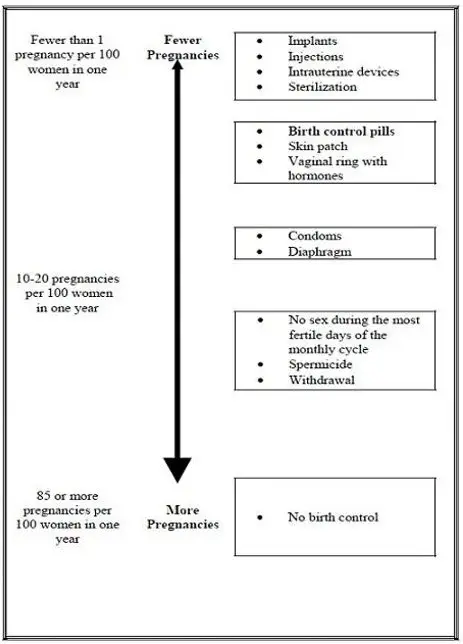
Who should not use Haloette?
Do not use Haloette if you:
- smoke and are over 35 years old
- have or have had blood clots in your arms, legs, eyes, or lungs
- have an inherited problem with your blood that makes it clot more than normal
- have had a stroke
- have had a heart attack
- have certain heart valve problems or heart rhythm problems that can cause blood clots to form in the heart
- have high blood pressure that medicine can't control
- have diabetes with kidney, eye, nerve, or blood vessel damage
- have certain kinds of severe migraine headaches with aura, numbness, weakness, or changes in vision, or have any migraine headaches if you are over age 35
- have liver disease, including liver tumors
- take any Hepatitis C drug combination containing ombitasvir/paritaprevir/ritonavir, with or without dasabuvir. This may increase levels of the liver enzyme "alanine aminotransferase" (ALT) in the blood
- have unexplained vaginal bleeding
- are pregnant or think you may be pregnant. Haloette is not for pregnant women.
- have or have had breast cancer or any cancer that is sensitive to female hormones
- are allergic to etonogestrel, ethinyl estradiol or any of the ingredients in Haloette. See the list of ingredients in Haloette at the end of this leaflet.
Hormonal birth control methods may not be a good choice for you if you have ever had jaundice (yellowing of the skin or eyes) caused by pregnancy or related to previous use of hormonal birth control.
Tell your healthcare provider if you have ever had any of the conditions listed above. Your healthcare provider can suggest another method of birth control.
What should I tell my healthcare provider before using Haloette?
Before you use Haloette tell your healthcare provider if you:
- have any medical conditions
- smoke
- are pregnant or think you are pregnant
- recently had a baby
- recently had a miscarriage or abortion
- have a family history of breast cancer
- have or have had breast nodules, fibrocystic disease, an abnormal breast x-ray, or abnormal mammogram
- use tampons and have a history of toxic shock syndrome
- have been diagnosed with depression
- have had liver problems including jaundice during pregnancy
- have or have had elevated cholesterol or triglycerides
- have or have had gallbladder, liver, heart, or kidney disease
- have diabetes
- have a history of jaundice (yellowing of the skin or eyes) caused by pregnancy (also called cholestasis of pregnancy)
- have a history of scanty or irregular menstrual periods
- have any condition that makes the vagina become irritated easily
- have or have had high blood pressure
- have or have had migraines or other headaches or seizures
- are scheduled for surgery. Haloette may increase your risk of blood clots after surgery. You should stop using Haloette at least 4 weeks before you have surgery and not restart it until at least 2 weeks after your surgery.
- are scheduled for any laboratory tests. Certain blood tests may be affected by hormonal birth control methods.
- are breastfeeding or plan to breastfeed. Hormonal birth control methods that contain estrogen, like Haloette, may decrease the amount of milk you make. A small amount of hormones from Haloette may pass into your breastmilk. Consider another non-hormonal method of birth control until you are ready to stop breastfeeding.
- have (or have ever had) an allergic reaction while using Haloette, including hives, swelling of the face, lips, tongue, and/or throat causing difficulty in breathing or swallowing (anaphylaxis and/or angioedema).
Tell your healthcare provider about all medicines and herbal products you take, including prescription and over-the-counter medicines, vitamins and herbal supplements.
Some medicines and herbal products may make hormonal birth control less effective, including, but not limited to:
- certain anti-seizure medicines (such as barbiturates, carbamazepine, felbamate, oxcarbazepine, phenytoin, rufinamide and topiramate)
- medicine to treat fungal infections (griseofulvin)
- certain combinations of HIV medicines, (such as nelfinavir, ritonavir, darunavir/ritonavir, (fos)amprenavir/ritonavir, lopinavir/ritonavir, and tipranavir/ritonavir)
- certain hepatitis C (HCV) medicines (such as boceprevir and telaprevir)
- non-nucleoside reverse transcriptase inhibitors (such as efavirenz and nevirapine)
- medicine to treat tuberculosis (such as rifampicin and rifabutin)
- medicine to treat high blood pressure in the vessels of the lung (bosentan)
- medicine to treat chemotherapy-induced nausea and vomiting (aprepitant)
- St John's wort
Use an additional barrier contraceptive method (such as a male condom with spermicide) when you take medicines that may make Haloette less effective. Since the effect of another medicine on Haloette may last up to 28 days after stopping the medicine, it is necessary to use the additional barrier contraceptive method for that long to help prevent you from becoming pregnant. While using Haloette, you should not use certain female barrier contraceptive methods such as a vaginal diaphragm, cervical cap or female condom as your back-up method of birth control because Haloette may interfere with the correct placement and position of a diaphragm, cervical cap or female condom.
Some medicines and grapefruit juice may increase the level of ethinyl estradiol in your blood if used together, including:
- the pain reliever acetaminophen
- ascorbic acid (vitamin C)
- medicines that affect how your liver breaks down other medicines (such as itraconazole, ketoconazole, voriconazole, fluconazole, clarithromycin, erythromycin, and diltiazem)
- certain HIV medicines (atazanavir/ritonavir and indinavir)
- non-nucleoside reverse transcriptase inhibitors (such as etravirine)
- medicines to lower cholesterol such as atorvastatin and rosuvastatin
Hormonal birth control methods may interact with lamotrigine, a medicine used for seizures. This may increase the risk of seizures, so your healthcare provider may need to adjust your dose of lamotrigine.
Women on thyroid replacement therapy may need increased doses of thyroid hormone.
Ask your healthcare provider if you are not sure if you take any of the medicines listed above. Know the medicines you take. Keep a list of them to show your doctor and pharmacist when you get a new medicine.
How should I use Haloette?
- Read the Instructions for Use at the end of this Patient Information that comes with your Haloette for information about the right way to use Haloette.
- Use Haloette exactly as your healthcare provider tells you to use it.
- Haloette is used in a 4-week cycle.
- Insert 1 Haloette in the vagina and keep it in place for 3 weeks (21 days). Regularly check that Haloette is in your vagina (for example, before and after intercourse) to ensure that you are protected from pregnancy.
- Remove the Haloette for a 1-week break (7 days). During the 1-week break (7 days), you will usually have your menstrual period.
Note: Insert and remove Haloette on the same day of the week and at the same time: - For example, if you insert your Haloette on a Monday at 8:00 am, you should remove it on the Monday 3 weeks later at 8:00 am.
- After your 1-week (7 days) break, you should insert a new Haloette on the next Monday at 8:00 am.
- While using Haloette, you should not use certain female barrier contraceptive methods such as a vaginal diaphragm, cervical cap or female condom as your back-up method of birth control because Haloette may interfere with the correct placement and position of a diaphragm, cervical cap or female condom.
- Ring breakage has occurred when also using a vaginal product such as a lubricant or treatment for infection (see "What should I do if my Haloette comes out of my vagina?"). Use of spermicides or vaginal yeast products will not make Haloette less effective at preventing pregnancy.
- Use of tampons will not make Haloette less effective or stop Haloette from working.
- If Haloette has been left inside your vagina for more than 4 weeks (28 days), you may not be protected from pregnancy and you should see your healthcare provider to be sure you are not pregnant. Until you know the results of your pregnancy test, you should use an extra method of birth control, such as male condoms with spermicide, until the new Haloette has been in place for 7 days in a row.
- Do not use more than 1 Haloette at a time. Too much hormonal birth control medicine in your body may cause nausea, vomiting, or vaginal bleeding.
Your healthcare provider should examine you at least 1 time a year to see if you have any signs of side effects from using Haloette.
What are the possible side effects of using Haloette?
See "What is the most important information I should know about Haloette?"
Haloette may cause serious side effects, including:
blood clots. Like pregnancy, combination hormonal birth control methods increase the risk of serious blood clots (see following graph), especially in women who have other risk factors, such as smoking, obesity, or age greater than 35. This increased risk is highest when you first start using a combination hormonal birth control method or when you restart the same or different combination hormonal birth control method after not using it for a month or more. Talk with your healthcare provider about your risk of getting a blood clot before using etonogestrel and ethinyl estradiol vaginal ring or before deciding which type of birth control is right for you.
In some studies of women who used etonogestrel and ethinyl estradiol vaginal ring, the risk of getting a blood clot was similar to the risk in women who used combination birth control pills.
Other studies have reported that the risk of blood clots was higher for women who use combination birth control pills containing desogestrel (a progestin similar to the progestin in etonogestrel and ethinyl estradiol vaginal ring) than for women who use combination birth control pills that do not contain desogestrel.
It is possible to die or be permanently disabled from a problem caused by a blood clot, such as heart attack or stroke. Some examples of serious blood clots are blood clots in the:
- legs (deep vein thrombosis)
- lungs (pulmonary embolus)
- eyes (loss of eyesight)
- heart (heart attack)
- brain (stroke)
To put the risk of developing a blood clot into perspective: If 10,000 women who are not pregnant and do not use hormonal birth control are followed for one year, between 1 and 5 of these women will develop a blood clot. The figure below shows the likelihood of developing a serious blood clot for women who are not pregnant and do not use hormonal birth control, for women who use hormonal birth control, for pregnant women, and for women in the first 12 weeks after delivering a baby.
Likelihood of Developing a Serious Blood Clot (Venous Thromboembolism [VTE])
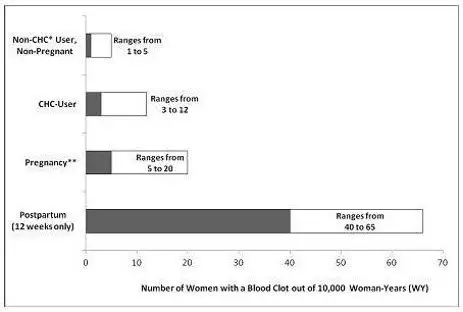
*CHC=combination hormonal contraception
**Pregnancy data based on actual duration of pregnancy in the reference studies. Based on a model assumption that pregnancy duration is nine months, the rate is 7 to 27 per 10,000 WY.
Call your healthcare provider right away if you have:
- leg pain that does not go away
- sudden shortness of breath
- sudden blindness, partial or complete
- severe pain or pressure in your chest
- sudden, severe headache unlike your usual headaches
- weakness or numbness in an arm or leg, or trouble speaking
- yellowing of the skin or eyeballs
Other serious risks include:
- Toxic Shock Syndrome (TSS). Some of the symptoms are much the same as the flu, but they can become serious very quickly. Call your healthcare provider or get emergency treatment right away if you have the following symptoms:
|
|
- allergic reaction, including hives, swelling of the face, lips, tongue, and/or throat causing difficulty in breathing or swallowing (anaphylaxis and/or angioedema)
- liver problems, including liver tumors
- high blood pressure
- gallbladder problems
- accidental insertion into bladder
- symptoms of a problem called angioedema if you already have a family history of angioedema
The most common side effects of Haloette are:
- tissue irritation inside your vagina or on your cervix
- headache (including migraine)
- mood changes (including depression, especially if you had depression in the past). Call your healthcare provider immediately if you have any thoughts of harming yourself.
- Haloette problems, including the ring slipping out or causing discomfort
- nausea and vomiting
- vaginal discharge
- weight gain
- vaginal discomfort
- breast pain, discomfort, or tenderness
- painful menstrual periods
- abdominal pain
- acne
- less sexual desire
Some women have spotting or light bleeding during Haloette use. If these symptoms occur, do not stop using Haloette. The problem will usually go away. If it doesn't go away, check with your healthcare provider.
Other side effects seen with Haloette include breast discharge; vaginal injury (including pain, discomfort, and bleeding) associated with broken rings; and penis discomfort of the partner (such as irritation, rash, itching).
Less common side effects seen with combination hormonal birth control include:
- Blotchy darkening of your skin, especially on your face
- High blood sugar, especially in women who already have diabetes
- High fat (cholesterol, triglycerides) levels in the blood
There have been reports of the ring becoming stuck to the vaginal tissue and having to be removed by a healthcare provider. Call your healthcare provider if you are unable to remove your Haloette.
Tell your healthcare provider about any side effect that bothers you or that does not go away. These are not all the possible side effects of Haloette. For more information, ask your healthcare provider or pharmacist. Call your healthcare provider for medical advice about side effects. You may report side effects to FDA at 1-800-FDA-1088.
How should I store Haloette and throw away used Haloettes?
- Store Haloette at room temperature between 68°F to 77°F (20°C to 25°C).
- Store Haloette at room temperature for up to 6 months after you receive it. Throw Haloette away if the expiration date on the label has passed.
- Do not store Haloette above 86°F (30°C).
- Avoid direct sunlight.
- Place the used Haloette in the re-closable foil pouch and properly throw it away in your household trash out of the reach of children and pets. Do not flush your used Haloette down the toilet.
Keep Haloette and all medicines out of the reach of children.
General information about the safe and effective use of Haloette
Medicines are sometimes prescribed for purposes other than those listed in the Patient Information. Do not use Haloette for a condition for which it was not prescribed. Do not give Haloette to other people. It may harm them.
This leaflet summarizes the most important information about Haloette. If you would like more information, talk with your healthcare provider. You can ask your pharmacist or healthcare provider for information about Haloette that is written for health professionals.
For more information on Haloette, call 1-844-825-8500.
What are the ingredients in Haloette?
Active ingredients: etonogestrel and ethinyl estradiol
Inactive ingredients: ethylene vinylacetate copolymers (28% and 9% vinylacetate) and magnesium stearate.
Haloette is not made with natural rubber latex.
Do Hormonal Birth Control Methods Cause Cancer?
It is not known if hormonal birth control causes breast cancer. Some studies, but not all, suggest that there could be a slight increase in the risk of breast cancer among current users with longer duration of use. If you have breast cancer now, or have had it in the past, do not use hormonal birth control because some breast cancers are sensitive to hormones.
Women who use hormonal birth control methods may have a slightly higher chance of getting cervical cancer. However, this may be due to other reasons such as having more sexual partners.
What should I know about my period when using Haloette?
When you use Haloette you may have bleeding and spotting between periods, called unplanned bleeding. Unplanned bleeding may vary from slight staining between menstrual periods to breakthrough bleeding, which is a flow much like a regular period. Unplanned bleeding occurs most often during the first few months of Haloette use, but may also occur after you have been using Haloette for some time. Such bleeding may be temporary and usually does not indicate any serious problems. It is important to continue using the ring on schedule. If the unplanned bleeding or spotting is heavy or lasts for more than a few days, you should discuss this with your healthcare provider.
What if I miss my regular scheduled period when using Haloette?
Some women miss periods on hormonal birth control, even when they are not pregnant. Consider the possibility that you may be pregnant if:
- you miss a period and Haloette was out of the vagina for more than 3 hours during the 3 weeks (21 days) of ring use
- you miss a period and waited longer than 1 week to insert a new ring
- you have followed the instructions and you miss 2 periods in a row
- you have left Haloette in place for longer than 4 weeks (28 days)
What if I want to become pregnant?
You may stop using Haloette whenever you wish. Consider a visit with your healthcare provider for a pre-pregnancy checkup before you stop using Haloette.
Instructions for Use
HALOETTE® (ha loe et)
(etonogestrel and ethinyl estradiol vaginal ring)
Read these Instructions for Use before you start using Haloette and each time you get a refill. There may be new information. This information does not take the place of talking to your healthcare provider about your treatment.
How should I start using Haloette?
If you are not currently using hormonal birth control, you have 2 ways to start using Haloette. Choose the best way for you:
- First Day Start: Insert Haloette on the first day of your menstrual period. You will not need to use another birth control method since you are using Haloette on the first day of your menstrual period.
- Day 2 to Day 5 Cycle Start: You may choose to start Haloette on days 2 to 5 of your menstrual period. Make sure you also use an extra method of birth control (barrier method), such as male condoms with spermicide for the first 7 days of Haloette use in the first cycle.
If you are changing from a birth control pill or patch to Haloette:
If you have been using your birth control method correctly and are certain that you are not pregnant, you can change to Haloette any day. Do not start Haloette any later than the day you would start your next birth control pill or apply your patch.
If you are changing from a progestin-only birth control method, such as a minipill, implant or injection or from an intrauterine system (IUS):
- You may switch from a minipill on any day. Start using Haloette on the day that you would have taken your next minipill.
- You should switch from an implant or the IUS and start using Haloette on the day that you remove the implant or IUS.
- You should switch from an injectable and start using Haloette on the day when your next injection would be due.
If you are changing from a minipill, implant or injection or from an intrauterine system (IUS), you should use an extra method of birth control, such as a male condom with spermicide during the first 7 days of using Haloette.
If you start using Haloette after an abortion or miscarriage:
- Following a first trimester abortion or miscarriage: You may start Haloette within 5 days following a first trimester abortion or miscarriage (the first 12 weeks of pregnancy). You do not need to use an additional birth control method.
- If you do not start Haloette within 5 days after a first trimester abortion or miscarriage, use a non-hormonal birth control method, such as male condoms and spermicide, while you wait for your period to start. Begin Haloette at the time of your next menstrual period. Count the first day of your menstrual period as "Day 1" and start Haloette one of the following 2 ways below.
- First Day Start: Insert Haloette on the first day of your menstrual period. You will not need to use another birth control method since you are using Haloette on the first day of your menstrual period.
- Day 2 to Day 5 Cycle Start: You may choose to start Haloette on Days 2 to 5 of your menstrual period. Make sure you also use an extra method of birth control (barrier method), such as male condoms with spermicide for the first 7 days of Haloette use in the first cycle.
- Following a second trimester abortion or miscarriage: You may start using Haloette no sooner than 4 weeks (28 days) after a second trimester abortion (after the first 12 weeks of pregnancy).
If you are starting Haloette after childbirth:
- You may start using Haloette no sooner than 4 weeks (28 days) after having a baby if you are not breastfeeding.
- If you have not gotten your menstrual period after childbirth, you should talk to your healthcare provider. You may need a pregnancy test to make sure you are not pregnant before you start using Haloette.
- Use another birth control method such as male condoms with spermicide for the first 7 days in addition to Haloette.
If you are breastfeeding you should not use Haloette. Use other birth control methods until you are no longer breastfeeding.
Step 1. Choose a position for insertion of Haloette.
- Choose the position that is comfortable for you. For example, lying down, squatting, or standing with 1 leg up (See Figures A, B, and C).
Positions for Haloette insertion
Step 2. Open the pouch to remove your Haloette.
- Each Haloette comes in a re-sealable foil pouch.
- Wash and dry your hands before removing Haloette from the foil pouch.
- Open the foil pouch at either notch near the top.
- Keep the foil pouch so you can place your used Haloette in it before you throw it away in your household trash.
Step 3. Prepare Haloette for insertion.
- Hold Haloette between your thumb and index finger and press the sides of the ring together (See Figures D and E).
Step 4. Insert Haloette into your vagina.
- Insert the folded Haloette into your vagina and gently push it further up into your vagina using your index finger (See Figures F and G).
- When you insert Haloette it may be in different positions in your vagina, but Haloette does not have to be in an exact position for it to work (See Figures H and I).
- Haloette may move around slightly within your vagina. This is normal. Although some women may be aware of Haloette in the vagina, most women do not feel it when it is in place.
Inserting Haloette (Figure F, Figure G) and positioning Haloette (Figure H, Figure I)
Note:
- If the Haloette feels uncomfortable, you may not have pushed the ring into your vagina far enough. Use your finger to gently push the Haloette as far as you can into your vagina. There is no danger of Haloette being pushed too far up in the vagina or getting lost (See Figure G).
- Some women have accidentally inserted Haloette into their bladder. If you have pain during or after insertion and you cannot find Haloette in your vagina, call your healthcare provider right away.
- Regularly check that Haloette is in your vagina (for example, before and after intercourse) to ensure you are protected from pregnancy.
Step 5. How do I remove Haloette?
- Wash and dry your hands.
- Choose the position that is most comfortable for you (See Figures A, B, and C).
- Put your index finger into your vagina and hook it through the Haloette. Gently pull downward and forward to remove the Haloette and pull it out (See Figure J).
Step 6. Throw away the used Haloette.
- Place the used Haloette in the re-sealable foil pouch and put it in a trash can out of the reach of children and pets.
- Do not throw Haloette in the toilet.
What else should I know about using Haloette?
What if I leave Haloette in too long?
- If you leave Haloette in your vagina for up to 4 weeks (28 days) you will still be getting pregnancy protection. Remove your old Haloette for 1 week (7 days) and insert a new Haloette 1 week (7 days) later (See Steps 1 through 4).
- If you leave Haloette in your vagina longer than 4 weeks (28 days), remove the ring and check to make sure you are not pregnant.
If you are not pregnant, insert a new Haloette (See Steps 1 through 4). You must use another birth control method, such as male condoms with spermicide, until the new Haloette has been used for 7 days in a row.
What should I do if my Haloette comes out of my vagina?
Haloette can slip or accidentally come out (expelled) of your vagina, for example, during sexual intercourse, bowel movements, use of tampons, or if it breaks.
- Haloette may break causing the ring to lose its shape. If the ring stays in your vagina this should not lower Haloette's effectiveness at preventing pregnancy.
- If Haloette breaks and slips out of your vagina, throw the broken ring in your household trash out of the reach of children and pets.
- Insert a new Haloette (See Steps 1 through 4).
- You should pay attention when removing a tampon to be sure that your Haloette is not accidentally pulled out.
- Be sure to insert Haloette before inserting a tampon.
- If you accidentally pull out your Haloette while using tampons, rinse your Haloette in cool to lukewarm (not hot) water and insert it again right away.
- Haloette can be pushed out of (expelled from) your vagina, for example, during sexual intercourse or during a bowel movement.
- If the expelled ring has been out of your vagina for less than 3 hours, rinse the expelled Haloette in cool to lukewarm (not hot) water and insert it again right away.
- If the expelled Haloette has been out of your vagina for more than 3 continuous hours:
- During Weeks 1 and 2, you may not be protected from pregnancy. Reinsert the ring as soon as you remember (See Steps 1 through 4). Use another birth control method, such as male condoms with spermicide, until the ring has been in place for 7 days in a row.
-
During Week 3, do not reinsert the Haloette that has been out of your vagina; but throw it away in your household trash away from children and pets. Use another birth control method, such as male condoms with spermicide, until the new Haloette has been used for 7 days in a row, following one of the two options below:
- -
- Option 1. Insert a new ring right away to start your next 21 Day Haloette use cycle. You may not have your regular period, but you may have spotting or vaginal bleeding.
- -
- Option 2. Insert a new ring no later than 7 days from the time the previous ring was removed or expelled. During this time, you may have your period.
- If Haloette was out of the vagina for an unknown amount of time, you may not be protected from pregnancy. Perform a pregnancy test prior to inserting a new ring and consult your healthcare provider.
This Patient Information and Instructions for Use have been approved by the U.S. Food and Drug Administration.
Distributed by:
Mayne Pharma
Greenville, NC 27834
Revised: 05/2022
| HALOETTE
etonogestrel and ethinyl estradiol insert, extended release |
||||||||||||||||||||
|
||||||||||||||||||||
|
||||||||||||||||||||
|
||||||||||||||||||||
|
||||||||||||||||||||
|
||||||||||||||||||||
| Labeler - Mayne Pharma Inc. (867220261) |
| Establishment | |||
| Name | Address | ID/FEI | Business Operations |
|---|---|---|---|
| Mithra Pharmaceuticals CDMO S.A. | 371418215 | MANUFACTURE(51862-148) | |





